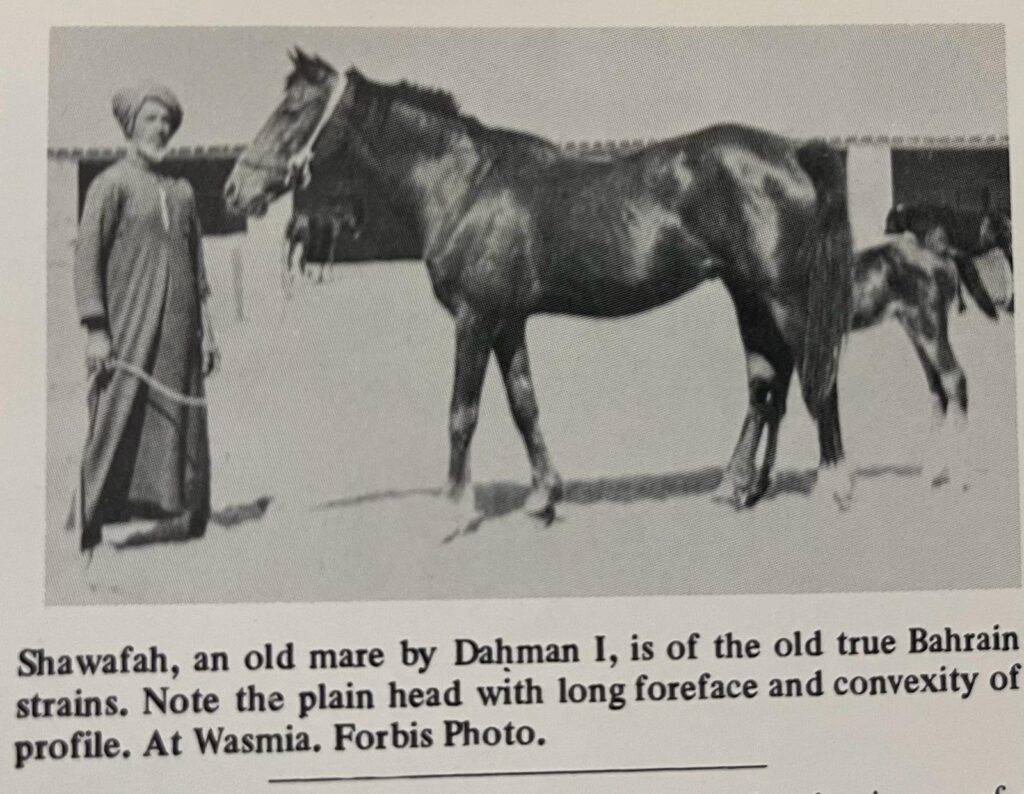H.R.P. Dickson (ca. 1930) and Judith Forbis (1970) on the “roman-nosed” Shawaf strain
I wrote about H.R.P. Dickson’s 1949 book “The Arab of the Desert” in an earlier blog entry about the Ubayyan strain of Ibn Jalawi. This entry is about about the horses of the rulers of Bahrain, in the context of Dickson’s mention of specific Arab leader being famous for keeping a certain strain of Arabian horses, their rabat or marbat:
Every Shaikh of standing is supposed to always keep his rabat, i.e. a mare or mares from which he breeds a certain particular strain. He gets name and prestige by doing this. […] The Shaikhs of Bahrain similarly keep the Roman-nosed Shawaf (Kuhailan) breed.
Kate referred me to this quote a few weeks ago. Several things struck me about it. First, how Dickson, who collected information for his book between 1929 and 1936, primarily associated the Bahraini rulers with the Shawaf strain rather than the Jallabi strain for which they are usually better known.
Second, how Judith Forbis, who visited the royal studs of Bahrain in March 1970, forty years after Dickson (or his informants) made their observation, essentially echoed him about both the look and the status of the Shawaf strain. In her 1971 seminal Arabian Horse World article “Pearls of Great Price”, Judi mentioned that an earlier ruler of Bahrain, “Shaykh Hamad was known to prefer the convex-profiled Shawaf stallions“. She also wrote:
Most educational among the herd was a convex-nosed old Shawafah mare of the early true Bahrain strains and a living contradiction (as were some others of her family and that of the Krayon [sic] strain) to the concept that an Arabian must have a beautiful head, or that it is necessarily indicative of purity. Indeed, human selection has produced the result that many desert-bred Arabians do not have beautiful heads, and the Arabs of Bahrain consider a “dish” somewhat of a deformity and a hindrance to good breathing!
Before I will leave you with that quote, below is a photo of that same Shawafah mare, from Judi’s Authentic Arabian Bloodstock.

So, in 1970, “the Arabs of Bahrain consisdered a dish somewhat of a deformity”. In 2024, I still do.
It’s a little hard to tell with the grain of the photo, but Shawafah also looks like she might have a bit of ‘nasal bump’ the way some horses – especially Egyptians/Egyptian-breds – do.
I don’t know whether or not this is a compliment, but she also looks rather a lot like some of the older European Warmbloods. Functional. Sturdy. Big shoulder and big hip, with a nice angle to the croup and the pelvis. That’s a horse that could definitely ‘sit’ in the gaits as well as push.
by the way, the mare in the photo, daughter of Dahman I, is the dam line of the stallion Shawaf Al Betaar, sire of Tuwaisaan Thaathaa at Jenny Lees. The mare in the photo was at Wasmiya in 1970, where Jellaby Alwasmiya was the main sire (he is named after the stud). And the granddam of Shawaf Albetaar, a mare born in 1965, was the daughter of Jellaby Alwasmiya, meaning she was out of a mare at Wasmiya. She is most likely Shawafah Alouda (the Old Shawafah), number (518) in volume 2 of the Amiri Arabian Stud Book. Or maybe her daughter.
Oh, that’s a very different sort of head from the ones I am used to seeing. Reminds me rather of Kheyra, the Astraled x Rosa Rugosa daughter. Come to think of it, I’m not certain I’ve seen a Bahraini horse with any degree of dish to their profile.